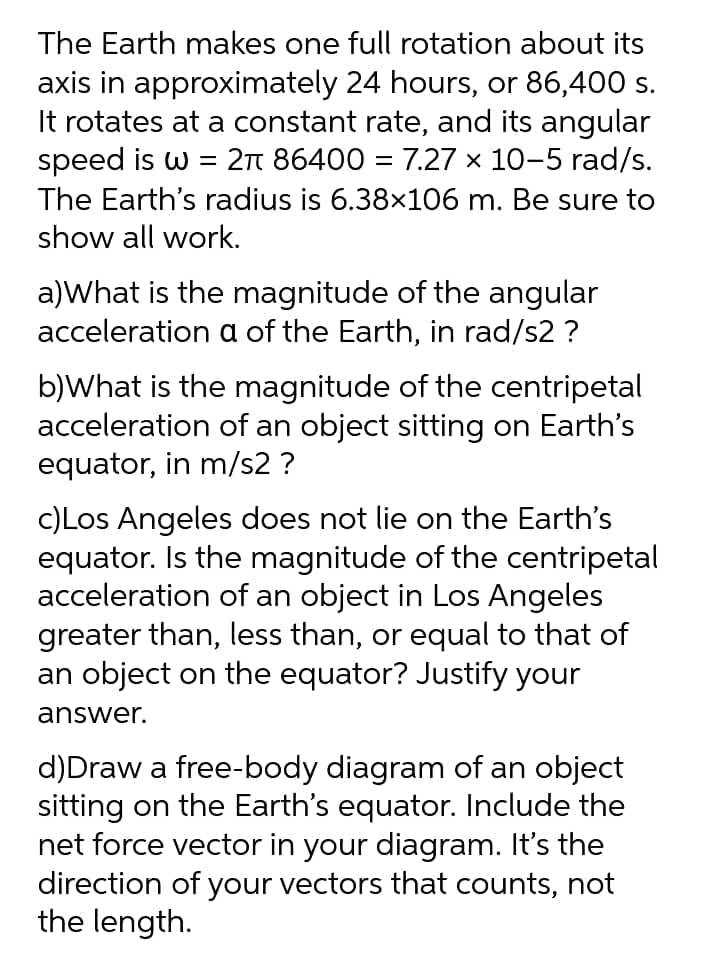The Earth makes one full rotation about its axis in approximately 24 hours, or 86,400 s. It rotates at a constant rate, and its angular speed is w = 2n 86400 = 7.27 x 10-5 rad/s. The Earth's radius is 6.38x106 m. Be sure to show all work. a)What is the magnitude of the angular acceleration a of the Earth, in rad/s2 ? b)What is the magnitude of the centripetal acceleration of an object sitting on Earth's equator, in m/s2 ? c)Los Angeles does not lie on the Earth's equator. Is the magnitude of the centripetal acceleration of an object in Los Angeles greater than, less than, or equal to that of an object on the equator? Justify your answer.
The Earth makes one full rotation about its axis in approximately 24 hours, or 86,400 s. It rotates at a constant rate, and its angular speed is w = 2n 86400 = 7.27 x 10-5 rad/s. The Earth's radius is 6.38x106 m. Be sure to show all work. a)What is the magnitude of the angular acceleration a of the Earth, in rad/s2 ? b)What is the magnitude of the centripetal acceleration of an object sitting on Earth's equator, in m/s2 ? c)Los Angeles does not lie on the Earth's equator. Is the magnitude of the centripetal acceleration of an object in Los Angeles greater than, less than, or equal to that of an object on the equator? Justify your answer.
Physics for Scientists and Engineers, Technology Update (No access codes included)
9th Edition
ISBN:9781305116399
Author:Raymond A. Serway, John W. Jewett
Publisher:Raymond A. Serway, John W. Jewett
Chapter10: Rotation Of A Rigid Object About A Fixed Axis
Section: Chapter Questions
Problem 10.3OQ: A wheel is rotating about a fixed axis with constant angular acceleration 3 rad/s2. At different...
Related questions
Concept explainers
Angular speed, acceleration and displacement
Angular acceleration is defined as the rate of change in angular velocity with respect to time. It has both magnitude and direction. So, it is a vector quantity.
Angular Position
Before diving into angular position, one should understand the basics of position and its importance along with usage in day-to-day life. When one talks of position, it’s always relative with respect to some other object. For example, position of earth with respect to sun, position of school with respect to house, etc. Angular position is the rotational analogue of linear position.
Question

Transcribed Image Text:The Earth makes one full rotation about its
axis in approximately 24 hours, or 86,400 s.
It rotates at a constant rate, and its angular
speed is w = 2n 86400 = 7.27 x 10-5 rad/s.
The Earth's radius is 6.38×106 m. Be sure to
show all work.
a)What is the magnitude of the angular
acceleration a of the Earth, in rad/s2 ?
b)What is the magnitude of the centripetal
acceleration of an object sitting on Earth's
equator, in m/s2 ?
c)Los Angeles does not lie on the Earth's
equator. Is the magnitude of the centripetal
acceleration of an object in Los Angeles
greater than, less than, or equal to that of
an object on the equator? Justify your
answer.
d)Draw a free-body diagram of an object
sitting on the Earth's equator. Include the
net force vector in your diagram. It's the
direction of your vectors that counts, not
the length.
Expert Solution
This question has been solved!
Explore an expertly crafted, step-by-step solution for a thorough understanding of key concepts.
This is a popular solution!
Trending now
This is a popular solution!
Step by step
Solved in 3 steps with 3 images

Knowledge Booster
Learn more about
Need a deep-dive on the concept behind this application? Look no further. Learn more about this topic, physics and related others by exploring similar questions and additional content below.Recommended textbooks for you

Physics for Scientists and Engineers, Technology …
Physics
ISBN:
9781305116399
Author:
Raymond A. Serway, John W. Jewett
Publisher:
Cengage Learning

Physics for Scientists and Engineers: Foundations…
Physics
ISBN:
9781133939146
Author:
Katz, Debora M.
Publisher:
Cengage Learning

Principles of Physics: A Calculus-Based Text
Physics
ISBN:
9781133104261
Author:
Raymond A. Serway, John W. Jewett
Publisher:
Cengage Learning

Physics for Scientists and Engineers, Technology …
Physics
ISBN:
9781305116399
Author:
Raymond A. Serway, John W. Jewett
Publisher:
Cengage Learning

Physics for Scientists and Engineers: Foundations…
Physics
ISBN:
9781133939146
Author:
Katz, Debora M.
Publisher:
Cengage Learning

Principles of Physics: A Calculus-Based Text
Physics
ISBN:
9781133104261
Author:
Raymond A. Serway, John W. Jewett
Publisher:
Cengage Learning

University Physics Volume 1
Physics
ISBN:
9781938168277
Author:
William Moebs, Samuel J. Ling, Jeff Sanny
Publisher:
OpenStax - Rice University

Glencoe Physics: Principles and Problems, Student…
Physics
ISBN:
9780078807213
Author:
Paul W. Zitzewitz
Publisher:
Glencoe/McGraw-Hill

College Physics
Physics
ISBN:
9781305952300
Author:
Raymond A. Serway, Chris Vuille
Publisher:
Cengage Learning